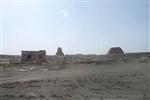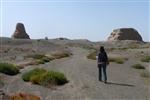- Getting around Lijiang. Dont stay in the Old Towns more than 2 days, there is nothing to do. KRISS Oct 9, 2013 05:46
- 2013 Beijing Temple Fair BENNYLAU Feb 26, 2013 03:29
- Malaysian traveling from KUL - LAX vis Shanghai PVG ZATI_DY Jan 3, 2013 20:15
Disappointing Destination in Xinjiang''s Desert
- Views: 6498
- |Vote: 0 0
- |Add to Favorites
- |Recommend to Friends
It's not often that I am disappointed by tourist destinations while I travel around China - especially here in Xinjiang - but it does happen on occasion. Most of the time I am blown away by the landscapes whose beauty is breathtaking or the history behind some ruin that keeps my imagination running wild for days. Perhaps it's not the actual location which disappoints me about certain places, though, but rather all the tourist hype that surrounds it. While standing at the Ha Noi ruins near the city of Kashgar I watched as a passenger train chugged by and the thought actually crossed my mind - "Gee, I bet that train is more interesting."
Upon first arriving in Kashgar I was presented with a myriad places I could visit: the Old City, the Karakoram Highway, the Id Kah mosque, the Abah Khoja Mausoleum, Ha Noi ruins...the list seemed to go on forever and most of these places really are incredible to see. However, the limited time I had here required me to choose some destinations while forgoing others. How do I choose? In hind sight (which, as they say, is always 20/20) I should have chosen which tourist spots I wanted to visit before arrival, but now I was stuck having to rely on poorly translated tourism pamphlets.
I think it was the words "ruins", "Tang dynasty" and "ancient temple" that sold me. If you can use those words to describe any tourism spot it must be worth seeing, right? Unfortunately in order to verify whether it is actually worth seeing you have to travel about 35 km (22 miles) northeast of Kashgar. Considering the dirt roads and the fact that our local driver wasn't even quite sure how to get there, it took us a good 45 minutes.
As we drove up to the guard shack we found 3 men playing cards while shading themselves from the glaring sun. Our car was the only thing making noise in the desert and when the driver shut off the engine everything went eerily silent. We were the only ones there, on a holiday no less, and it looked as if they hadn't seen another tourist in days. No wonder. I still wasn't quite sure what I was looking at. I half expected tumbleweed to come rolling past along with the sound of a screaming vulture.
To be fair, I have to explain the the Mor Buddhist Stupa, which makes up half of the Ha Noi ruins, is in the least an interesting structure sticking up in the middle of a pretty flat desert. The cylindrical column on the top reaches 12.8 meters in height with a square foundation that measures about 12m x 12m. According to archaeologists it once occupied a place of importance in a 7th-century town that was abandoned in the 12th century and has since fallen prey to the elements. Now the stupa is one of only two structures that remain and the other can barely be qualified as anything other than a huge rock.
There are no signs giving historical information about these ruins. No tour guides provide commentary while you soak in the view. You can't even climb on the base of the ruins to take pictures. The actual amount of time we spent looking at the Ha Noi ruins totaled maybe 15 minutes compared to the hour and a half of travel we had to endure to get here.
The only morsel of a story I was able to dig up about this place was the claim that Xuanzang, a famous Chinese Buddhist monk who became famous for his trek to India and back, made a stop at this stupa to visit. Of course this is just speculation and still doesn't offer me any tangible reason why I should have been standing next to this huge mud lump. The fact is that most China travelers wouldn't even know who Xuanzang is anyway, much less care about where he stopped for lunch.
So there I was, cursing the pamphlets that let me to believe I should spend half a day and a bit of money to see this place. There I was between two mud stumps when the train slowly rolled by to the north and I was hit with the realization that they too could view these ruins from the comfort of their passenger car. I felt gypped. Kashgar is definitely worth a visit from anyone who loves history and culture, but don't be deceived by each fancy pamphlet you see. Some places, like the Ha Noi ruins, are just best seen through the window of a passing train car.
Tips and Prices
This place is so remote that no buses actually make their way near to the ruins, so the only way to physically see them (besides from the aforementioned train car) is to rent a car from a local travel agency. Fees vary from place to place, but you should be able to secure a car for anywhere between 100-200 RMB depending on the time of year. Entrance into the ruins is 15 RMB per ticket.
Of course, viewing the ruins can be done for free with the purchase of train tickets from Kashgar to Urumqi! Look to the south about 15-20 minutes after departure and be prepared to be disappointed.







 Copyright © 1998-2026 All rights reserved.
Copyright © 1998-2026 All rights reserved.
1.
Jul 1, 2009 07:07 Reply
CROL said:
I am planning a trip to Xinjiang this summer.
What places do you recommend?
I was thinking of Tianchi, Urumqi, Turpan...
Is it as hot as they say?
Thank you!!!